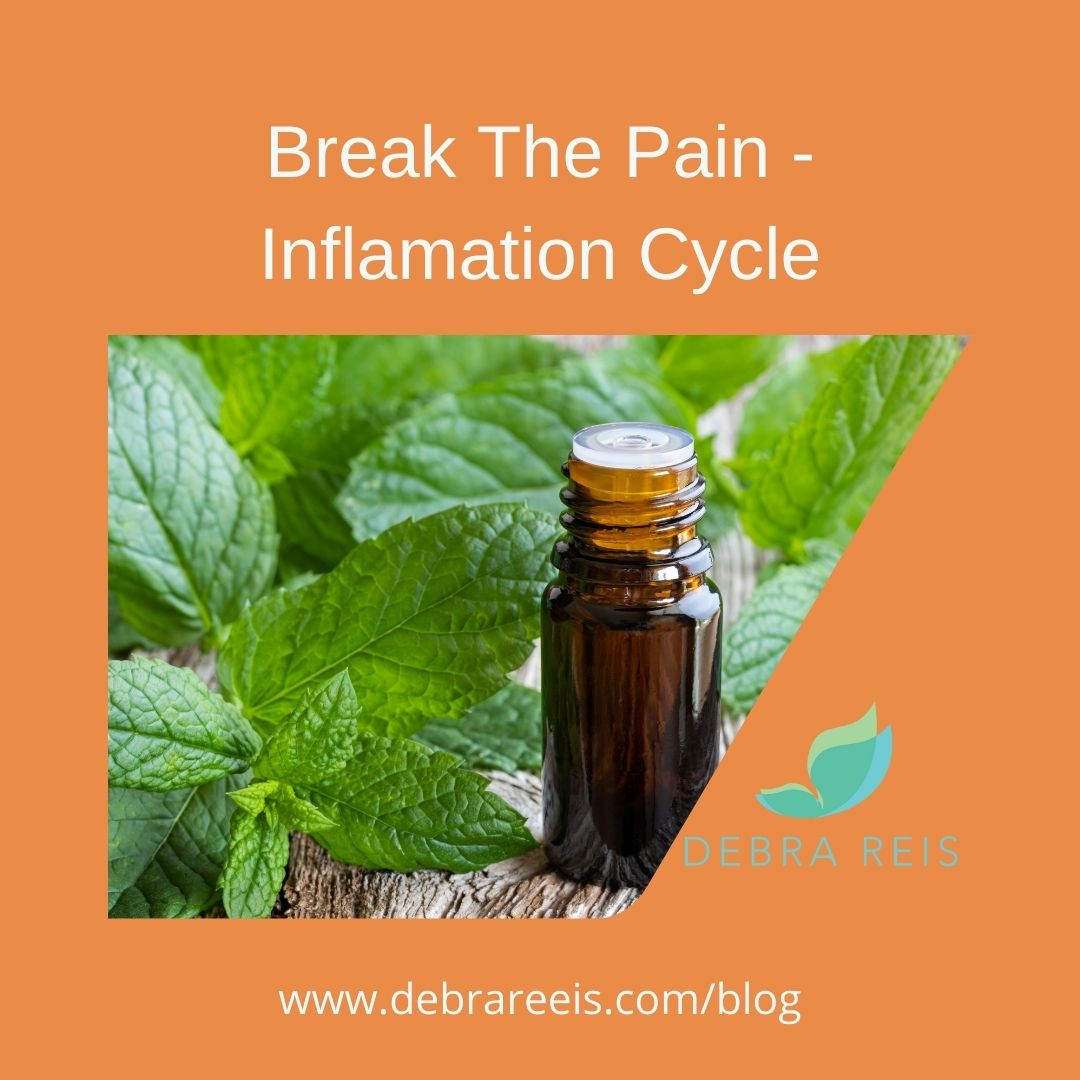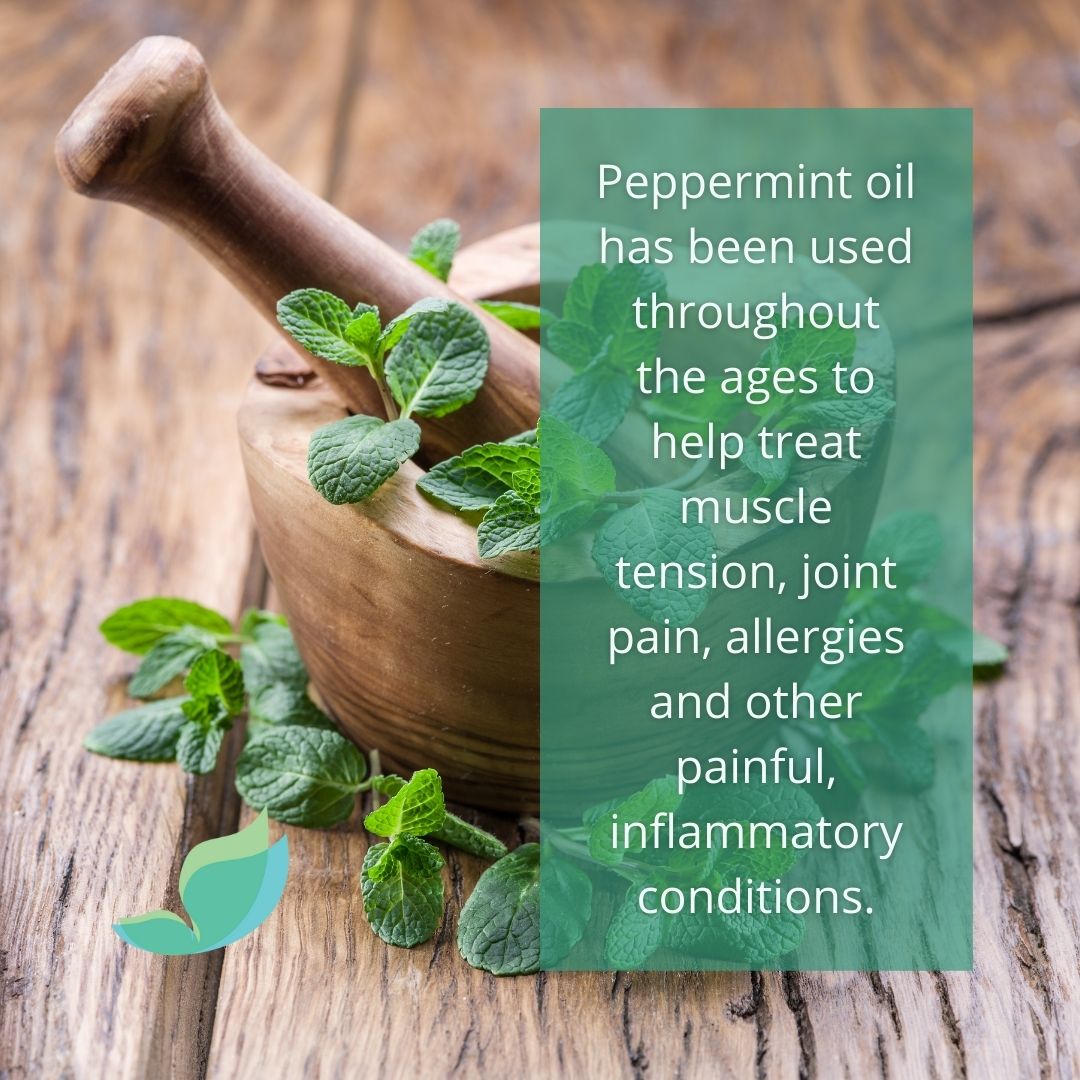BLOG
Supportive Therapies For Better Outcomes — Enrich Your Life Through Relaxation Techniques, Aromatherapy, and Gentle Movement.

Break the Pain - Inflammation Cycle with Peppermint Oil!
Which comes first, the pain or the inflammation? Well, one can “feed” the other. When inflammation occurs, there is pain. Pain releases substances that cause inflammation and the cycle continues. So, what can you do? Break the inflammation – pain cycle with aromatherapy such as Peppermint (Mentha piperita) essential oil. Peppermint oil is a popular leader in the aromatherapy world to reduce pain by cooling the flame.
The Cooling Action of Peppermint is the Chemical Constituent, Menthol

Menthol is a naturally occurring chemical constituent in peppermint oil called a monoterpene. Monoterpenes have a history for the therapeutic relief of pain when used topically. Menthol belongs to a class of analgesics known as counterirritants. Counterirritants can penetrate the outer layer of the skin and interact with sensory nerves close to the skin surface.
Menthol produces a cooling sensation on the skin, like an “icy hot” feeling. In reality, skin temperature does not change, but the perception of cooling occurs on the skin receptors. Applied topically, menthol helps to release an inflammatory mediator in the body called substance P. Substance P is known to modulate the transmission of pain signals to the brain leading to a reduced pain perception in the body.
The Gate Theory Phenomenon to Reduce Pain
The action of menthol in peppermint oil correlates with a phenomenon known as the Gate Theory. According to the Gate Theory, pain signals are prevented from reaching the brain. Menthol can prevent the strength of the pain signal to reach the brain and to feel the full pain sensation. The “gate” will not allow the signal to go through to the brain.
This action gives Menthol an analgesic effect on acute and inflammatory pain. In addition, Menthol can dilate local blood vessels in the skin, thereby improving blood flow to any areas of injury or inflammation bringing healing substances to promote healing.
This article, The role and mechanism of action of menthol in topical analgesic products, can give you more scientific details. (J. V. Pergolizzi Jr MD, R. Taylor Jr PhD, J.-A. LeQuang BA, R. B. Raffa PhD, for the NEMA Research Group, 10 March 2018
Menthol Contains Anti-Inflammatory Effects to Reduce Pain

Inflammation is the body’s natural defense mechanism against harmful invaders or injury. In most cases, inflammation is essential for the healing process and bringing back balance to the body. However, when the pain – inflammation cycle continues, it can be detrimental to the body.
A clinical study published in the European Journal of Medical Research examined the anti-inflammatory potential of menthol. The authors found that menthol reduced the production of certain inflammatory markers in a lab study. The finding suggests that menthol has anti-inflammatory properties that could be useful to help treat inflammatory conditions, like asthma or allergies.
Using Peppermint Oil Wisely
Peppermint oil has been used throughout the ages to help treat muscle tension, joint pain, allergies and other painful, inflammatory conditions.
Inhalation – this is one of the best methods to use peppermint oil to reduce pain quickly. Place a drop of oil onto a tissue and deeply inhale when acute pain occurs such as a headache or muscle strain. DO NOT use for asthma as it may irritate and create bronchial spasm.
Diffusion – diffusing peppermint is a great way to help in recovery after a painful experience. Some people like diffusing after exercise to help their muscles recover after a strenuous workout or physical activity.
Topical – this has been the most studied way of using Peppermint oil for pain relief. Due to the possible menthol irritation, peppermint oil should be diluted into a carrier oil before application to the skin.
Begin with 1-2 drops of Peppermint oil into a teaspoon of your organic carrier oil (examples include coconut oil, olive oil, almond oil). Use all or part of the mixture over your area of concern. You may wish to do this 3-4 times per day. If you are dealing with a chronic concern, consider adding another essential oil with Peppermint oil (examples include Lavender, Copaiba, Orange oils).
SAFETY
Peppermint Oil has safety considerations
Do NOT use with children under the age of 5 years. It may cause bronchospasms.
Do NOT use with the condition of atrial fibrillation. Peppermint has known to stimulate atrial fib.
Do NOT use near the eyes as it can cause irritation and discomfort. If this should happen, flush the eye with an emulsifier such as coconut oil, olive oil, or copious amounts of water.


Break the Pain - Inflammation Cycle with Peppermint Oil!
Which comes first, the pain or the inflammation? Well, one can “feed” the other. When inflammation occurs, there is pain. Pain releases substances that cause inflammation and the cycle continues. So, what can you do? Break the inflammation – pain cycle with aromatherapy such as Peppermint (Mentha piperita) essential oil. Peppermint oil is a popular leader in the aromatherapy world to reduce pain by cooling the flame.
The Cooling Action of Peppermint is the Chemical Constituent, Menthol

Menthol is a naturally occurring chemical constituent in peppermint oil called a monoterpene. Monoterpenes have a history for the therapeutic relief of pain when used topically. Menthol belongs to a class of analgesics known as counterirritants. Counterirritants can penetrate the outer layer of the skin and interact with sensory nerves close to the skin surface.
Menthol produces a cooling sensation on the skin, like an “icy hot” feeling. In reality, skin temperature does not change, but the perception of cooling occurs on the skin receptors. Applied topically, menthol helps to release an inflammatory mediator in the body called substance P. Substance P is known to modulate the transmission of pain signals to the brain leading to a reduced pain perception in the body.
The Gate Theory Phenomenon to Reduce Pain
The action of menthol in peppermint oil correlates with a phenomenon known as the Gate Theory. According to the Gate Theory, pain signals are prevented from reaching the brain. Menthol can prevent the strength of the pain signal to reach the brain and to feel the full pain sensation. The “gate” will not allow the signal to go through to the brain.
This action gives Menthol an analgesic effect on acute and inflammatory pain. In addition, Menthol can dilate local blood vessels in the skin, thereby improving blood flow to any areas of injury or inflammation bringing healing substances to promote healing.
This article, The role and mechanism of action of menthol in topical analgesic products, can give you more scientific details. (J. V. Pergolizzi Jr MD, R. Taylor Jr PhD, J.-A. LeQuang BA, R. B. Raffa PhD, for the NEMA Research Group, 10 March 2018
Menthol Contains Anti-Inflammatory Effects to Reduce Pain

Inflammation is the body’s natural defense mechanism against harmful invaders or injury. In most cases, inflammation is essential for the healing process and bringing back balance to the body. However, when the pain – inflammation cycle continues, it can be detrimental to the body.
A clinical study published in the European Journal of Medical Research examined the anti-inflammatory potential of menthol. The authors found that menthol reduced the production of certain inflammatory markers in a lab study. The finding suggests that menthol has anti-inflammatory properties that could be useful to help treat inflammatory conditions, like asthma or allergies.
Using Peppermint Oil Wisely
Peppermint oil has been used throughout the ages to help treat muscle tension, joint pain, allergies and other painful, inflammatory conditions.
Inhalation – this is one of the best methods to use peppermint oil to reduce pain quickly. Place a drop of oil onto a tissue and deeply inhale when acute pain occurs such as a headache or muscle strain. DO NOT use for asthma as it may irritate and create bronchial spasm.
Diffusion – diffusing peppermint is a great way to help in recovery after a painful experience. Some people like diffusing after exercise to help their muscles recover after a strenuous workout or physical activity.
Topical – this has been the most studied way of using Peppermint oil for pain relief. Due to the possible menthol irritation, peppermint oil should be diluted into a carrier oil before application to the skin.
Begin with 1-2 drops of Peppermint oil into a teaspoon of your organic carrier oil (examples include coconut oil, olive oil, almond oil). Use all or part of the mixture over your area of concern. You may wish to do this 3-4 times per day. If you are dealing with a chronic concern, consider adding another essential oil with Peppermint oil (examples include Lavender, Copaiba, Orange oils).
SAFETY
Peppermint Oil has safety considerations
Do NOT use with children under the age of 5 years. It may cause bronchospasms.
Do NOT use with the condition of atrial fibrillation. Peppermint has known to stimulate atrial fib.
Do NOT use near the eyes as it can cause irritation and discomfort. If this should happen, flush the eye with an emulsifier such as coconut oil, olive oil, or copious amounts of water.



